Filipino music features diverse scales and modes. Five-tone scales are commonly used in indigenous traditions****, creating unique melodic possibilities. For example, the traditional Filipino instrument, the kulintang, often uses a five-tone scale.
The introduction of Christianity in the Philippines led to the incorporation of diatonic scales in Filipino music. However, regional variations persist. The use of different scales and modes contributes to the rich musical heritage of the country.
Different modes are used to evoke various emotions in Filipino music. The Ionian mode is often used to convey joy, as seen in traditional Filipino celebrations. On the other hand, The Aeolian mode is often used to evoke sadness, as seen in Filipino ballads. Contemporary Filipino music blends these modes, showcasing a dynamic interplay between tradition and innovation.
Traditional Filipino Scales
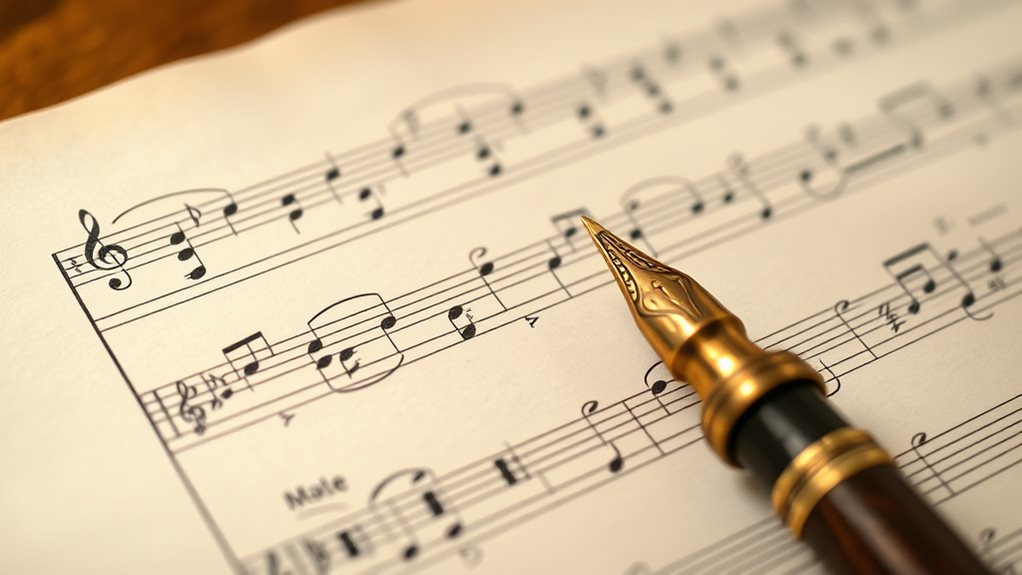
Traditional Filipino music is built on diverse melodic structures that play a significant role in its unique soundscapes. The diatonic scale is a key component of Philippine folk music, unlike the prevalent pentatonic scales of other Asian musics.
Regional variations across the archipelago contribute to the diversity of these melodic structures. In the southern region, kulintang, agung, and gangsa are commonly used instruments, while the northern region features unbossed gongs.
Indigenous tribes from Taiwan also brought their unique musical traditions and scales to the Philippines. For example, the Cordillera region boasts distinctive flat gongs (gangsà) used in ways that differ significantly from the bossed gongs of Muslim and animist groups in the south.
These melodic structures aren't solely dependent on the instruments themselves, as individual preferences and geographic location also contribute to their diversity. The precise tuning of kulintang instruments varies, reflecting individual preferences and contributing to the unique sonic character of each ensemble.
Rhythmic patterns also show great variety, depending on the instrumentation and geographic location. The interplay between melodic structures and the rhythmic patterns in the dabakan and gandang accompanying gong music is a prime example of this complexity.
Five-Tone and Six-Tone Scales
Philippine Folk Music Scales
In addition to the diatonic scale, Philippine folk music features scales with fewer tones, including five-tone and six-tone scales. These scales are commonly played on traditional instruments like the *kutiyapi* and *kulintang* gongs.
Five-Tone Scales
Five-tone scales are widely used in indigenous traditions and are integral to the musical dialects of numerous Philippine societies. These scales have unique interval patterns that differ from Western scales, offering a distinct melodic depth. They often involve interlocking repeated parts, allowing for extensive melodic improvisation. For example, the *kutiyapi*, a traditional stringed instrument, is often played using five-tone scales, enabling musicians to create complex and varied melodies.
Six-Tone Scales
Six-tone scales, though less common, are another significant aspect of Philippine music. They may reflect the influence of Christianized music, adapting diatonic scales to local tastes. These scales can exhibit greater harmonic complexity and may have led to instrumental innovation and changes in performance styles. For instance, adapted versions of traditional instruments are often used to play six-tone scales, showcasing the blending of cultural influences in Philippine music.
Comparison of Five-Tone and Six-Tone Scales
| Feature | Five-Tone Scales | Six-Tone Scales |
|---|---|---|
| Prevalence | Widely used in indigenous traditions | Less common than five-tone scales |
| Instrumentation | Traditional instruments like *kutiyapi* and *kulintang* gongs | Adapted versions of traditional instruments |
| Melodic Structure | Often involves interlocking repeated parts | May exhibit greater harmonic complexity |
The unique characteristics of five-tone and six-tone scales contribute to the rich tapestry of Philippine music, showcasing a complex musical landscape resulting from cultural exchange and influences.
Indigenous Musical Practices

The Philippines is home to numerous ethnolinguistic groups, which contributes to the incredible diversity of its indigenous musical practices. Instruments such as the kutiyapi, kubing, tongatong, babendil, and kulintang ensembles showcase this diversity. The kutiyapi, for example, is a stringed instrument originating from Mindanao and the Visayas, while the kubing is a bamboo instrument used in rituals and social gatherings.
The tongatong, babendil, and kulintang ensembles, prevalent in southern islands, further exemplify this diversity.
Indigenous music in the Philippines plays a crucial role in cultural storytelling. It transmits history and traditions through generations, often through the accompaniment of instruments like the kutiyapi in narratives. Many instruments are integral to rituals, ceremonies, and life-cycle events, from births to funerals. Their use carries profound meaning, invoking blessings, warding off evil spirits, or communicating with ancestors.
Regional variations in indigenous music are notable, with the kulintang music of the Maguindanao and Maranao being particularly noteworthy. These ensembles, often featuring gongs and drums, demonstrate the vibrant tapestry of Filipino indigenous musical practices. The emphasis on hands-on teaching, alongside modern adaptations that respect tradition, ensures the survival of this rich heritage.
The resilience of indigenous music in the Philippines underscores its enduring power in shaping cultural identity and preserving the nation's diverse artistic heritage. Oral transmission and hands-on teaching methods have ensured the continuity of these traditions, preserving the unique musical identities of diverse indigenous communities.
Christian Music Influence
Christian Music Influence in the Philippines
The introduction of Christianity in the Philippines significantly impacted the country's musical landscape. A blend of Western and indigenous musical traditions led to the development of a unique Filipino musical identity.
Changes in Scales and Modes
Before Christian influence, Filipino music primarily used pentatonic and hexatonic scales. In contrast, after Christian influence, diatonic scales (major and minor) became prevalent. This shift also led to the adoption of Western modes such as Ionian, Aeolian, Mixolydian, and Dorian.
Harmony and Instrumentation
Prior to Christian influence, harmony in Filipino music was limited or absent. However, with the introduction of Christianity, major, minor, and dominant seventh chords became integral to the harmonic texture of Filipino music. Additionally, indigenous instruments were integrated with Western instruments, creating a distinctive sound.
Melodic Adaptation and Indigenous Integration
The melodic adaptation of Christian hymns in the Philippines often incorporated traditional instruments and vocal styles, such as trills and vibrato. Repetitive melodic structures from indigenous practices were also incorporated into Christian songs, demonstrating the interplay between traditions.
| Feature | Before Christian Influence | After Christian Influence |
|---|---|---|
| Scales | Pentatonic, hexatonic | Diatonic (major, minor) |
| Modes | Indigenous modes | Ionian, Aeolian, Mixolydian, Dorian |
| Harmony | Limited or absent | Major, minor, dominant seventh chords |
| Instrumentation | Indigenous instruments | Integration of Western and indigenous instruments |
Regional Musical Variations
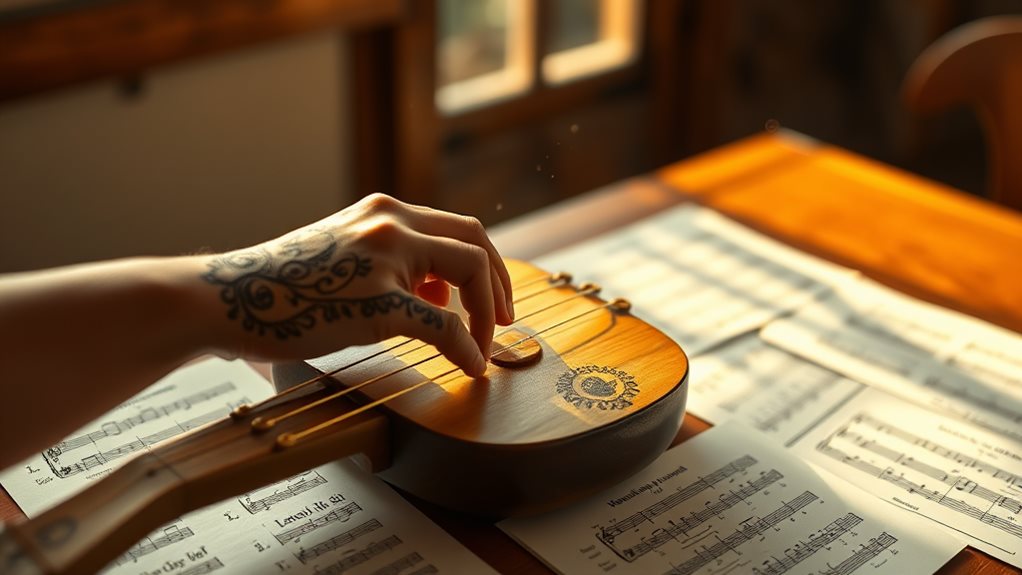
The Philippines is home to a diverse range of musical traditions, reflecting the nation's various ethnic groups and geographical regions. This diversity is evident in indigenous music, which has been shaped by cultural exchanges and unique instrumentations. For example, gong music differs significantly between the Cordillera region's flat gongs (gangsà) and the bossed gongs used in Mindanao and Palawan.
Kulintang music, prevalent in southern Philippines, has a rich history that predates colonial influence. This music features a variety of instruments, including the kutiyapi, basal, and babarak, each with its distinct sound and use. Gangsa music, on the other hand, showcases intricate rhythmic patterns through its pattong and toppaya styles.
Other regional instruments, such as the palas, sulibao, and kimbal drums, further highlight the diversity of Filipino music.
Vocal styles in the Philippines are equally varied, incorporating techniques like trills, vibrato, and glottal stops. Shamans, for instance, use a unique blend of speech and melodic vocal undulations. These vocal and instrumental techniques are integral components of larger aesthetic and spiritual practices.
Instrument construction and tuning also vary significantly, reflecting individual preferences and contributing to the region's unique sonic character.
Filipino ensemble music is a vibrant tapestry of different traditions, including kulintang ensembles, gong music, and vocal groups. These ensembles reflect not only local traditions but also the historical and cultural exchanges that have shaped the nation's music.
Ethnic Group Differences
Musical practices in the Philippines exhibit significant diversity across ethnic groups, reflecting unique cultural values and historical influences. The use of different instruments, such as the Kalinga's gangsa and the Ibaloy's kalsa and pinsak, contributes to this regional diversity. These instruments showcase the importance of traditional craftsmanship in shaping a group's musical identity.
Instrumentation and tuning variations also highlight individual and group preferences. For example, kulintang sets have different tuning variations, which impact performance authenticity. Indigenous scales, often five- or six-tone, differ from those in Christianized music, demonstrating historical influences on cultural expressions.
Performance styles further diversify Filipino music. The Kalinga's pattong and toppaya playing techniques, along with the Ibaloy's drum accompaniment, illustrate rhythmic variations. Melodic structures range from melismatic to syllabic, reflecting different approaches to cultural storytelling.
For instance, the use of interlocking repeated parts in Kalinga music shows a communal participation in shaping the musical landscape.
Aesthetically, the emphasis on individual timbres showcases local preferences. Improvisation plays a vital role in these musical traditions, reflecting their living nature.
The content of songs often serves as the chief aesthetic component, highlighting the importance of music in social contexts and its role in reinforcing cultural values.
Cordillera Music Traditions

Cordillera Music Traditions: A Rich Cultural Heritage
Cordillera music traditions showcase a diverse array of indigenous musical practices, reflecting the region's numerous ethnic groups. The gangsa, a flat gong, is central to many Cordillera musical expressions. These gongs are played using different techniques, including the patong style, which employs hard sticks, and the toppaya style, which uses the palm.
Instrumentation and Playing Styles
The Ibaloy people utilize a variety of instruments, including gangsa, kalsa, pinsak, and palas. No two sets of instruments are tuned identically, showcasing individual artistry. The patong and toppaya styles are used to play the gangsa, creating complex rhythms.
Musical Structure and Cultural Significance
The music's structure often involves interlocking repeated parts, as seen in Kalinga saggeypo. Melodic variations range from highly ornamented to speech-like. Improvisation plays a significant role in Cordillera music. Vocal techniques include trills, vibrato, and glottal stops. The music's context is deeply spiritual and social, accompanying dances, strengthening community bonds, and reflecting individual expression.
Performance Styles and Preservation Efforts
Cordillera music performances often feature dynamic movement and seated performances, accompanying dancers. The Ibaloy people, for example, use gangsa to accompany dancers. Efforts to preserve these traditions are ongoing, ensuring the unique sounds of the Cordillera continue to resonate.
Key Features of Cordillera Music Traditions
| Feature | Description | Example |
|---|---|---|
| Instrumentation | Gangsa, kalsa, pinsak, palas | Ibaloy gong ensembles |
| Playing Styles | Pattong (sticks), Toppaya (palm) | Rhythmic variations in gangsa music |
| Musical Structure | Interlocking repeated parts, melismatic ornamentation | Kalinga saggeypo |
| Cultural Significance | Spiritual ceremonies, social functions, community bonding | Ifugao gangha playing |
| Performance Styles | Dynamic movement, seated performances, accompanying dancers | Ibaloy gongs accompanying dancers |
Palawan and Maguindanao Music
Palawan and Maguindanao music showcase distinct aspects of the Philippines' rich musical heritage.
Palawan's musical style is largely defined by its modal usage. The Ionian mode is used in 94% of analyzed Palawan songs, creating a bright and joyful sound****. This is evident in the prevalent use of the Ionian mode in many Palawan songs. In contrast, The Aeolian mode**, found in around 5% of songs, evokes feelings of sadness or contemplation**. A notable example of this style can be heard in Lisa Sandei's recordings.
Additionally, the Mixolydian mode and the Yonanuki minor pentatonic scale, as seen in "Kmal Kmo Kau," add unique flavors to Palawan music. These diverse modes contribute to the emotional depth and rich stylistic range of Palawan music.
Maguindanao music presents a different musical landscape. The strong influence of Islamic and indigenous cultures is evident in Maguindanao rhythms. These rhythms often incorporate pentatonic and hexatonic scales typical of Southeast Asian traditions.
The music frequently reflects the region's history and cultural heritage, incorporating call-and-response patterns and potentially integrating Islamic chant melodies. This blend creates a vibrant musical landscape distinct from Palawan's modal focus. The integration of cultural influences shapes the unique character of Maguindanao musical expression, showcasing a different facet of Filipino musical diversity.
Traditional Instruments
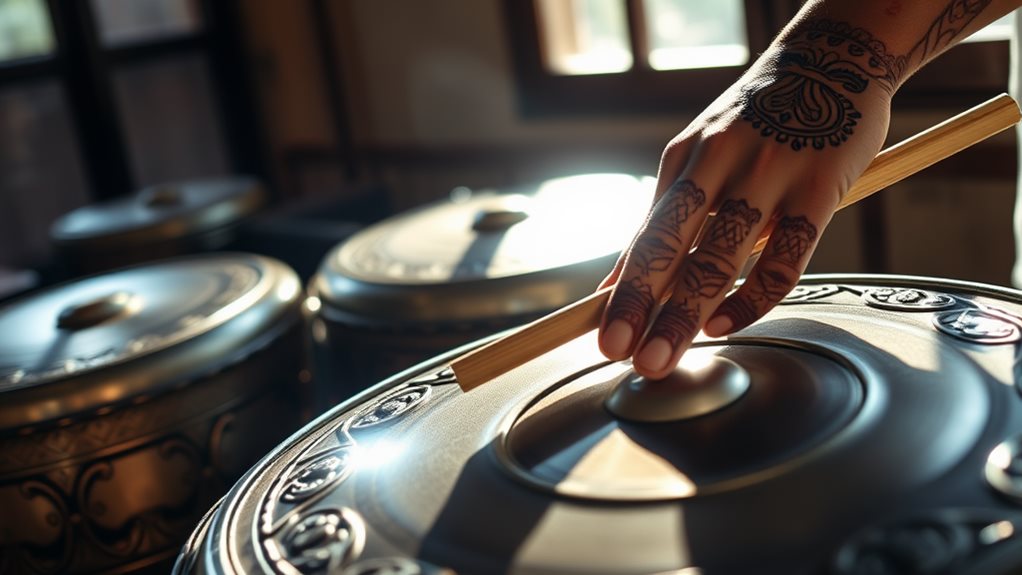
The Philippines' traditional instruments reflect a diverse cultural landscape. The country's varied musical heritage is showcased through its array of aerophones, chordophones, membranophones, and idiophones. Each instrument carries significant cultural significance, with craftsmanship that highlights the skill and artistry of Filipino artisans.
These instruments can be categorized by their material and method of sound production. The instrument families reveal the breadth of the nation's musical heritage.
- Aerophones are made from materials such as bamboo and wood. Examples include the Bulungudyong, Palendag, and Tongali, used by the Pinatubo Ayta and Kalinga groups.
- Chordophones include instruments like the Kudyapi, Litguit, and Faglong, made from materials such as wood and metal. These are used by communities in Mindanao, Aeta, and B'laan.
- Membranophones are made from animal hide and wood. Examples include the Dabakan, Gandang, and Libbit, used by the Maranao and Ifugao groups.
These instruments play a vital role in ceremonies, rituals, and social gatherings. For instance, the kulintang ensemble holds a prominent place in various cultural celebrations. Intricate designs and symbolic elements incorporated into many instruments further underscore their cultural value.
Regional variations in instrument design and playing styles can be observed, providing insights into the history, beliefs, and artistic expressions of diverse Filipino communities.
Studying these instruments offers a deeper understanding of the Philippines' rich cultural heritage. By examining the different instrument families and their cultural significance, we can gain a broader appreciation for the country's unique musical traditions.
Performance Styles and Techniques
Filipino musical performances are characterized by diverse styles and techniques. They showcase the country's varied cultural heritage through a range of melodic structures, from simple to highly ornamented and melismatic passages.
For example, vocal techniques like trills and glottal stops add expressive nuances to the performance.
Improvisation plays a significant role in Filipino music. Performers frequently embellish melodic themes or create entirely new musical phrases on the spot. This spontaneous creation allows for personal expression within established frameworks.
For instance, in rhythmic improvisation, performers create complex and repetitive patterns.
Rhythmic patterns form the backbone of many Filipino musical traditions. These patterns, often interlocking and repetitive, create complex rhythmic textures.
The gangsa and kulilal instruments demonstrate sophisticated use of polyphony****, where individual timbres and tonal resonance contribute to the overall aesthetic effect.
The social and ceremonial context heavily influences the performance style. It shapes the way music is experienced and interpreted.
In traditions like sanghiyang, a shift from speech-like chanting to more melodic vocalizations is observed, showcasing the diverse nature of Filipino musical performances.
Vocal and Instrumental Music
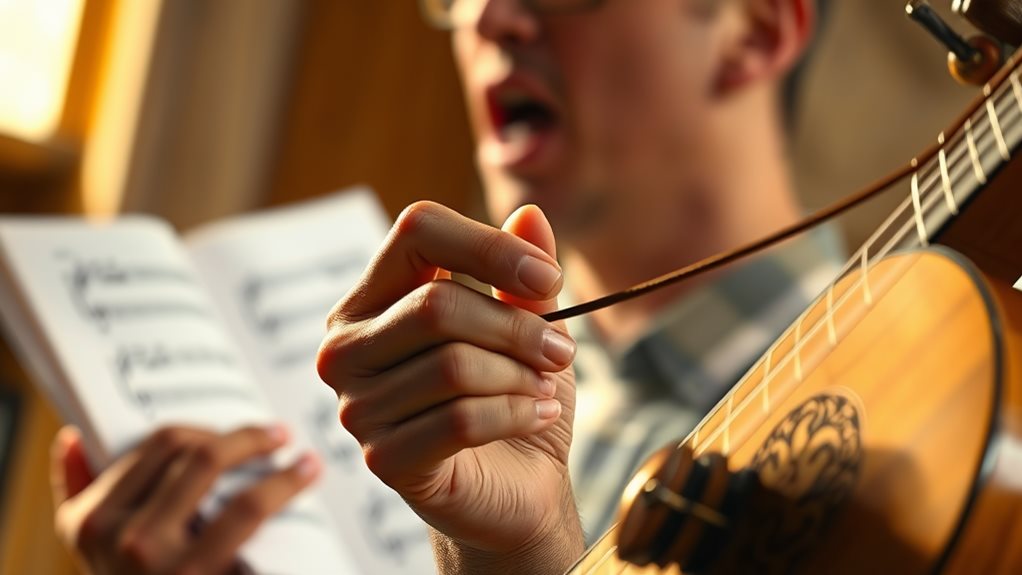
Filipino Music: A Blend of Indigenous Traditions and External Influences****
Filipino vocal and instrumental music is a rich tapestry of sound that combines indigenous traditions with external influences. Five- or six-tone scales are used in some regions, and intricate vocal techniques like trills and vibrato are common. The melodic structures of Filipino music range from ornamented to speech-like, reflecting the importance of the lyrics.
The harana and kundiman are popular lyrical songs that demonstrate the impact of Spanish rhythmic patterns on Filipino music. The adoption of diatonic scales** also shows the influence of Western music. Vocal improvisation** and ad-libbing are common in Filipino music, enriching the musical storytelling.
Indigenous Instruments and Ensembles
Filipino music features indigenous instruments like the kutiyapi and gangsa, as well as the kulintang ensemble. These instruments represent a rich musical heritage and are played in distinct styles across different regions.
The kulintang ensemble is particularly noteworthy for its intricate interplay of gongs and percussion.
The Role of Music in Filipino Life
Both vocal and instrumental music play significant roles in social events and ceremonies in the Philippines. The emotional context of music is deeply woven into the fabric of Filipino life, and musical storytelling is paramount in expressing cultural identity.
Emotional Expression in Music
Filipino Music Effectively Conveys Emotions Through Various Modes and Scales
Filipino music utilizes different modes and scales to convey a wide range of emotions. The Ionian mode, equivalent to the major scale, evokes bright and joyful feelings****, commonly used in celebratory music. This is because the major scale's pattern of whole and half steps creates a sense of resolution and finality, contributing to its uplifting quality.
On the other hand, the Aeolian mode, or the natural minor scale, lends itself to expressing sorrow and melancholy****. This is due to the minor scale's pattern of whole and half steps, which creates a sense of tension and uncertainty, contributing to its somber quality.
Other modes also play a significant role in expressing emotions in Filipino music. The Dorian mode, with its raised sixth, offers a hopeful minor feel, as seen in its use in various folk songs.
In contrast, the Phrygian mode, with its characteristic flat second, creates a darker, more dramatic sound, often found in flamenco music. Additionally, the Lydian mode, with its raised fourth, adds a mystical quality, showcasing the versatility of these scales in expressing nuanced emotions.
The cultural significance of these modes in Filipino music is undeniable. The use of specific modes in Filipino music shapes its emotional landscape, reflecting the depth and complexity of Filipino cultural experiences.
Mood and Atmosphere Creation
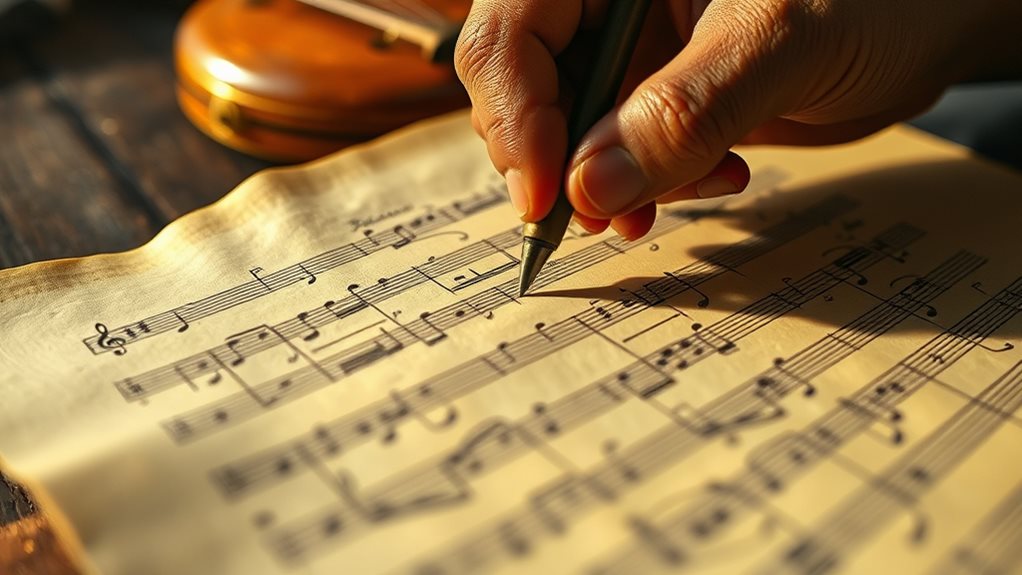
Mood and atmosphere play crucial roles in Filipino music, and they're achieved through a combination of various musical elements.
The sonic textures created by instruments like gongs and kulintang shape mood dynamics. For example, the expressive timbres of these instruments contribute to distinct atmospheric elements. In a kulintang ensemble, the layered, interlocking parts evoke a powerful sense of shared heritage. This contrasts with the intimate emotional landscapes portrayed in harana and kundiman. In these genres, major and minor keys, along with specific metrical choices, define the mood.
The introduction of Spanish colonial influence significantly impacted the development of Filipino music. New rhythmic patterns and melodic structures were introduced, creating syncretic forms that blend indigenous and Western elements. For instance, the use of binary and ternary forms builds dynamic shifts, while rondo form offers predictable returns that influence the overall atmospheric effect.
Vocal interpretation techniques, such as vibrato and trills, add emotional depth to Filipino music. Additionally, the choice of modes, like Ionian, Dorian, and Aeolian, significantly impacts the emotional landscape.
The interplay of various musical elements contributes to the diverse and nuanced mood dynamics of Filipino music. The combination of instrumental timbre, rhythmic influences, and modal choices creates a rich and complex musical experience that's unique to the Philippines.
Modern Musical Fusions
Modern Filipino music combines traditional practices with global influences to create a unique sound. The fusion of traditional modes and Western musical theory results in a rich harmonic landscape.
This blend is evident in the integration of Western scales, such as major and minor, alongside traditional melodies. For example, the use of Western instruments, like guitars and drums, alongside traditional instruments, such as the kulintang and kutyapi, expands the sonic palette. This combination pushes creative boundaries and showcases the dynamic interplay between indigenous and global influences.
Global genres like jazz and rock have also influenced Filipino music. The bluesy feel of the Mixolydian mode is often used in modern Filipino rock, while jazz improvisation techniques are evident in Filipino jazz. This fusion isn't just additive; it's transformative. Modern Filipino musicians experiment with unconventional uses of modes, creating entirely new soundscapes.
The key elements of modern Filipino music include:
- Integration of Western musical theory with traditional Filipino modes
- Innovative use of traditional Filipino instruments in modern contexts
- Significant influence of global music genres on Filipino musical styles
- Creative experimentation with modes and harmonic structures resulting in unique sounds
- Preservation of cultural identity through the incorporation of traditional elements
This creative fusion has led to a revitalization of Filipino music, appealing to both local and international audiences.
The result is a vibrant, evolving musical tradition that respects its heritage while embracing the future.
Contemporary Musical Applications

Contemporary Filipino Musical Expressions Blend Tradition and Modernity****
Contemporary Filipino musical expressions combine traditional and modern elements, creating a unique sound. This blend is evident in the continued use of traditional scales and modes within various genres. For example, the kulintang ensemble incorporates Javanese influences alongside indigenous scales, while harana and kundiman employ major and minor keys while retaining their traditional melodic structures.
Incorporating Traditional Scales into Modern Music
The Manila Sound, a product of the 1970s, seamlessly integrated traditional scales into a modern pop format. Original Pilipino Music (OPM) showcases this fusion further, incorporating influences from across Asia, Spain, and America. This blending of styles is also seen in the fusion of traditional Filipino music with Western structures and instruments.
For instance, traditional vocal techniques like trills and vibrato are incorporated into contemporary vocal styles, and innovative instrumental applications of instruments like the kutiyapi and kulintang are used.
Preserving Traditional Scales and Modes
Composers like Lucio San Pedro and Antonino Buenaventura played a crucial role in preserving traditional scales and modes by notating folk songs. Contemporary compositions skillfully utilize various modes, including Ionian, Dorian, and Phrygian, reflecting a deep understanding of traditional musical structures.
Chord progressions, melodic structures, and harmonic innovations all build upon this foundation, allowing for a unique sound that's both distinctly Filipino and modern in its approach.
Carrying Forward Traditional Music into Contemporary Performance
The rich cultural expression evident in traditional music is carried forward into contemporary performance through improvisation, dynamic range, distinctive timbral qualities, and audience engagement****.
These elements allow contemporary Filipino music to remain connected to its roots while still innovating and evolving.
Questions and Answers
How Are Scales Taught to Filipino Musicians?
In the Philippines, scales are taught to musicians through a blend of traditional teaching methods and Western influences. Cultural influences significantly shape the learning process, combining oral transmission with formal music theory. This unique approach emphasizes the importance of improvisation and practical experience in mastering scales.
For instance, Filipino musicians often learn scales through oral transmission, where they listen to and imitate their instructors or experienced musicians. This method helps them develop their ear and internalize the sound patterns of different scales.
In addition to oral transmission, Filipino musicians also study formal music theory to gain a deeper understanding of scales and their applications. Formal music theory provides a foundation for musicians to analyze and create complex melodies and harmonies. By combining oral transmission with formal music theory, Filipino musicians develop a strong foundation in scales and music theory.
What Notation Systems Are Used?
The Filipino notation systems combine traditional methods with Western influence, reflecting the cultural significance of the music. The Solfege system and the Staff notation system are commonly used in the Philippines. These systems vary in practice depending on the region, with no single system being dominant. For instance, in Western-influenced music, the staff notation system is widely used, while traditional Filipino music may use a combination of staff notation and solfege.
Are There Any Unusual Intervals Used?
Unusual intervals are indeed used. These variations are found in indigenous music, which incorporates unique intervallic structures not present in Western music. For instance, in some Native American music, intervals such as the "neutral third" (an interval between a major and minor third) are used, adding distinctiveness to the music. Similarly, in certain African musical traditions, microtones (intervals smaller than a semitone) are employed, further expanding the range of possible intervals.
Which Modes Are Most Popular Today?
Hip-hop and P-pop are the most popular music modes today. These genres showcase a mix of traditional influences and contemporary adaptations. For instance, hip-hop combines American and Filipino styles, while P-pop blends pop music with local themes and rhythms. Another notable genre is Manila Sound, which persists by blending different genres, such as rock, folk, and funk. Additionally, folk music has gained renewed popularity, with many artists incorporating traditional Filipino instruments and melodies into their music.
How Do Scales Change Over Time?
Scales are dynamic and have changed over time. Their evolution is a reflection of various cultural influences. As societies shift and musical exchange occurs, scales adapt and blend, sometimes leading to their disappearance.
For example, the ancient Egyptian scale system was different from what we use today. The introduction of new instruments and musical styles led to the creation of new scales and the evolution of existing ones. The Western major and minor scales, commonly used in music today, have their roots in ancient Greek scales, which were modified and adapted over time through cultural exchange and musical innovation.
The historical evolution of scales demonstrates their ability to change and adapt. This process is driven by the blending of different musical traditions and the introduction of new instruments and musical styles.